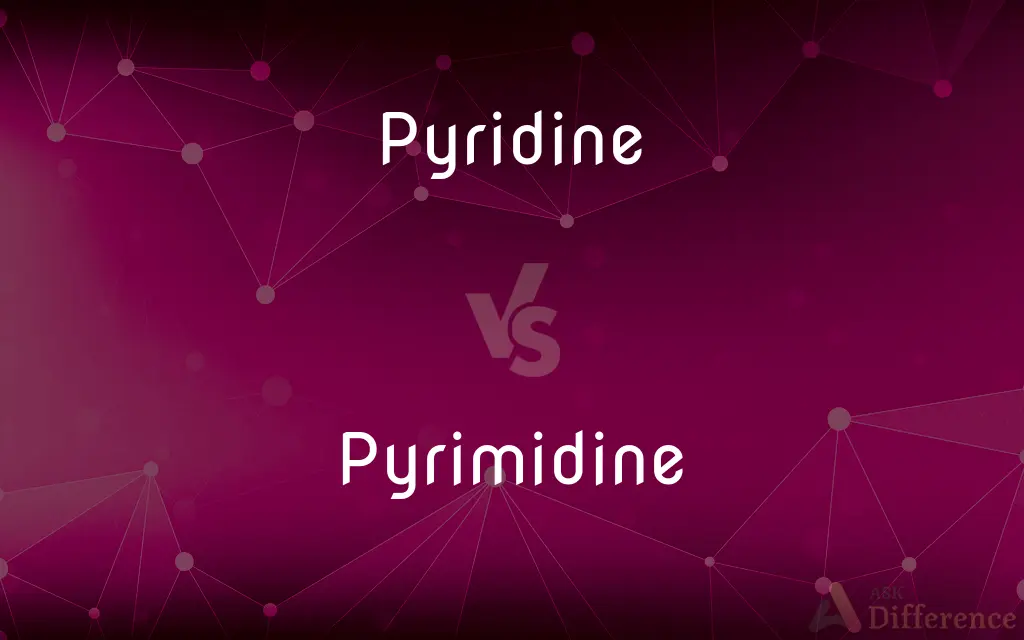Pyridine vs. Pyrimidine — What's the Difference?
Edited by Tayyaba Rehman — By Urooj Arif — Updated on March 19, 2024
Pyridine is a basic, aromatic nitrogen-containing heterocycle, while pyrimidine is a diazine with two nitrogen atoms in its ring.

Difference Between Pyridine and Pyrimidine
Table of Contents
ADVERTISEMENT
Key Differences
Pyridine is an organic compound with the chemical formula C5H5N, featuring a six-membered ring with one nitrogen atom, known for its basic nature and distinct, unpleasant odor. It serves as a foundational structure for many drugs, agrochemicals, and other organic compounds. Whereas, pyrimidine, with the formula C4H4N2, contains a similar six-membered ring but with two nitrogen atoms at positions 1 and 3. It is less basic than pyridine and plays a crucial role in the structure of nucleic acids, being part of the bases cytosine, thymine, and uracil.
Pyridine is used widely as a solvent and reagent in organic synthesis and industrial applications due to its basicity and ability to stabilize reaction intermediates. In contrast, pyrimidine derivatives are found in pharmaceuticals, agrochemicals, and are integral to genetic material, indicating its biological significance.
In terms of reactivity, pyridine undergoes electrophilic substitution reactions at the 3-position, which is the most electron-rich part of the ring. Pyrimidine, however, is less reactive due to the electron-withdrawing effect of its two nitrogen atoms, and its reactions often occur at the 2- and 4-positions.
Despite their structural similarities, the presence of one vs. two nitrogen atoms in their rings leads to significant differences in their chemical properties, applications, and roles in biological systems.
Comparison Chart
Formula
C5H5N
C4H4N2
ADVERTISEMENT
Nitrogen Atoms
One
Two
Basicity
Basic, due to lone pair on nitrogen
Less basic, as nitrogen lone pairs contribute to aromaticity
Role in Biology
Limited natural occurrence
Integral to nucleic acids (DNA and RNA)
Reactivity
Undergoes electrophilic substitution, preferably at the 3-position
Less reactive, with reactions often at the 2- and 4-positions
Applications
Solvent, reagent in organic synthesis
Found in pharmaceuticals, agrochemicals, and nucleic acids
Compare with Definitions
Pyridine
A basic nitrogen-containing heterocycle used widely as a solvent.
Pyridine is used in the synthesis of sulfapyridine, a drug for bacterial infections.
Pyrimidine
Less basic than pyridine due to nitrogen atoms contributing to aromaticity.
The reduced basicity of pyrimidine affects its reactivity in biochemical processes.
Pyridine
Known for its unpleasant, fish-like odor.
The distinct smell of pyridine is often noticeable in lab environments.
Pyrimidine
Integral to the structure of several vitamins and coenzymes.
Vitamin B1 (thiamine) contains a pyrimidine ring.
Pyridine
Serves as a building block for many pharmaceuticals and agrochemicals.
Nicotine is a well-known compound containing a pyridine ring.
Pyrimidine
Found in several important biological molecules like thymine and cytosine.
Mutations in the pyrimidine bases of DNA can lead to genetic disorders.
Pyridine
Used in the manufacture of herbicides and insecticides.
Pyridine derivatives are key ingredients in some commercial pest control products.
Pyrimidine
A diazine with two nitrogen atoms important in biological systems.
Pyrimidine bases are crucial components of DNA and RNA.
Pyridine
Pyridine is a basic heterocyclic organic compound with the chemical formula C5H5N. It is structurally related to benzene, with one methine group (=CH−) replaced by a nitrogen atom. It is a highly flammable, weakly alkaline, water-miscible liquid with a distinctive, unpleasant fish-like smell.
Pyrimidine
Pyrimidine derivatives have various pharmaceutical applications.
Certain anticancer drugs are designed to target pyrimidine metabolism.
Pyridine
A flammable, colorless or yellowish liquid base, C5H5N, having a penetrating odor and serving as the parent compound of many biologically important derivatives. It is used as a solvent and in the manufacture of various agricultural chemicals, rubber products, water repellents, dyes, and drugs.
Pyrimidine
Pyrimidine is an aromatic heterocyclic organic compound similar to pyridine. One of the three diazines (six-membered heterocyclics with two nitrogen atoms in the ring), it has the nitrogen atoms at positions 1 and 3 in the ring.
Pyridine
(organic compound) Any of a class of aromatic heterocyclic compounds containing a ring of five carbon atoms and an nitrogen atom; especially the simplest one, C5H5N.
Pyrimidine
A single-ringed, crystalline organic base, C4H4N2, that is the parent compound of a large group of biologically important compounds.
Pyridine
A nitrogenous base, C5H5N, obtained from the distillation of bone oil or coal tar, and by the decomposition of certain alkaloids, as a colorless liquid with a peculiar pungent odor. It is the nucleus of a large number of organic substances, among which several vegetable alkaloids, as nicotine and certain of the ptomaïnes, may be mentioned. See Lutidine.
Pyrimidine
Any of a group of substituted derivatives of pyrimidine, including the nitrogen bases uracil, cytosine, and thymine, which are components of nucleic acids. Barbiturates and certain other drugs are also pyrimidines.
Pyridine
A toxic colorless flammable liquid organic base with a disagreeable odor; usually derived from coal
Pyrimidine
(organic compound) A diazine in which the two nitrogen atoms are in the meta- positions; it is the basis of three of the bases found in DNA and RNA: thymine, uracil and cytosine
Pyrimidine
Any of several basic compounds derived from pyrimidine
Pyrimidine
A heterocyclic organic compound with a penetrating odor
Common Curiosities
Why is pyrimidine less reactive than pyridine?
The presence of two nitrogen atoms in pyrimidine, which contribute their lone pairs to the aromatic ring, makes the ring less electron-rich and the compound less reactive compared to pyridine.
What types of reactions are common for pyridine and pyrimidine?
Pyridine commonly undergoes electrophilic substitution reactions, particularly at the 3-position, while pyrimidine's reactions often occur at the 2- and 4-positions due to the electron-withdrawing effect of its nitrogen atoms.
Can pyridine and pyrimidine both be found in biological systems?
While pyrimidine is a key component of nucleic acids, pyridine's occurrence in nature is limited, and it is mostly used in synthetic applications.
How do pyridine and pyrimidine differ in their applications?
Pyridine is primarily used as a solvent and reagent in chemical synthesis, whereas pyrimidine derivatives are important in pharmaceuticals and are fundamental to genetic material.
How does the presence of nitrogen atoms affect the properties of pyridine and pyrimidine?
The nitrogen atoms significantly influence the basicity, reactivity, and applications of these compounds, with pyridine being more basic and pyrimidine being part of crucial biological molecules.
Can pyridine and pyrimidine rings be modified?
Yes, both pyridine and pyrimidine rings can undergo various chemical reactions to introduce different functional groups, affecting their properties and applications.
Are there drugs that contain pyridine or pyrimidine rings?
Many drugs contain pyridine or pyrimidine rings, utilizing their structural motifs for therapeutic effects in areas such as cancer treatment and antibacterial agents.
Is pyridine ever used in food or flavorings?
Despite its unpleasant smell, pyridine derivatives can be used in flavorings and food additives, though not pyridine itself due to its odor.
What is the primary structural difference between pyridine and pyrimidine?
Pyridine contains one nitrogen atom in its six-membered ring, while pyrimidine contains two at positions 1 and 3.
How does the basicity of pyridine and pyrimidine compare?
Pyridine is more basic due to the lone pair on the nitrogen not participating in aromaticity, unlike in pyrimidine where the lone pairs are part of the aromatic system.
Are pyridine and pyrimidine bases?
Pyridine acts as a base due to the lone pair on its nitrogen, but pyrimidine is less basic because its nitrogen atoms' lone pairs contribute to the ring's aromaticity.
Share Your Discovery

Previous Comparison
Stitching vs. Sewing
Next Comparison
Communist vs. BolshevikAuthor Spotlight
Written by
Urooj ArifUrooj is a skilled content writer at Ask Difference, known for her exceptional ability to simplify complex topics into engaging and informative content. With a passion for research and a flair for clear, concise writing, she consistently delivers articles that resonate with our diverse audience.
Edited by
Tayyaba RehmanTayyaba Rehman is a distinguished writer, currently serving as a primary contributor to askdifference.com. As a researcher in semantics and etymology, Tayyaba's passion for the complexity of languages and their distinctions has found a perfect home on the platform. Tayyaba delves into the intricacies of language, distinguishing between commonly confused words and phrases, thereby providing clarity for readers worldwide.














































